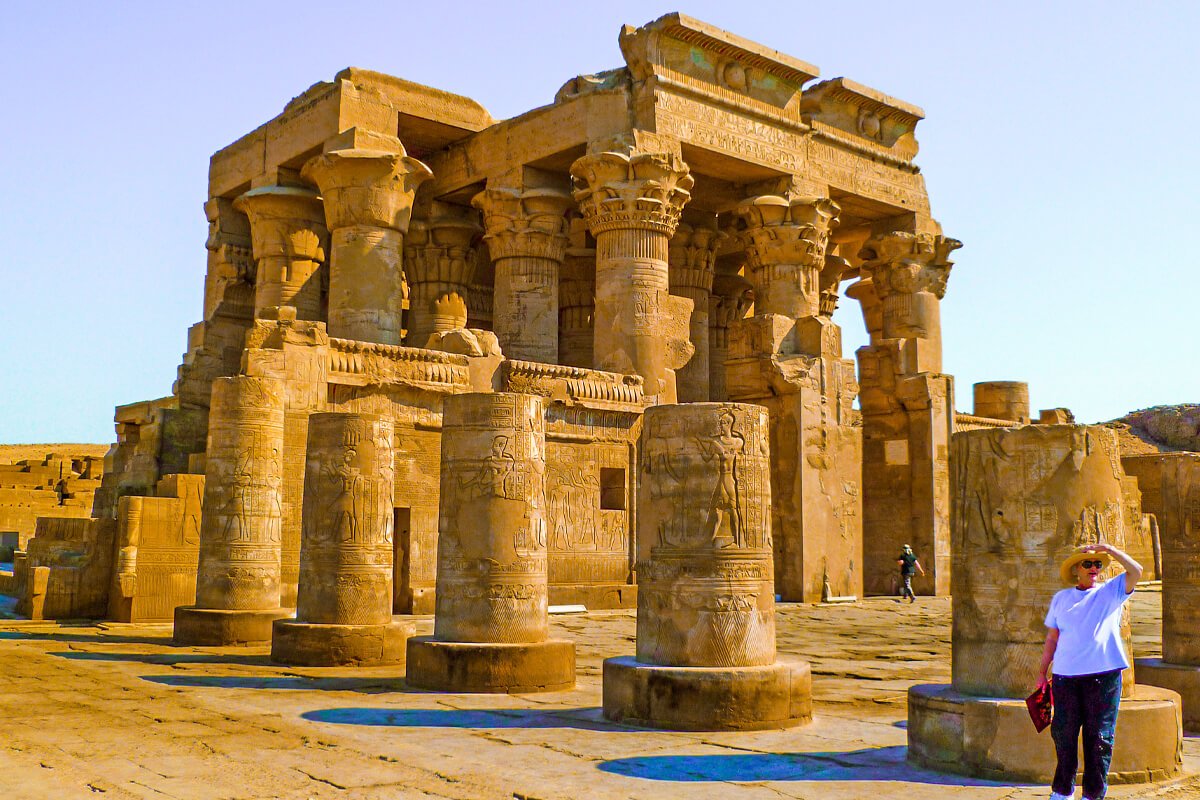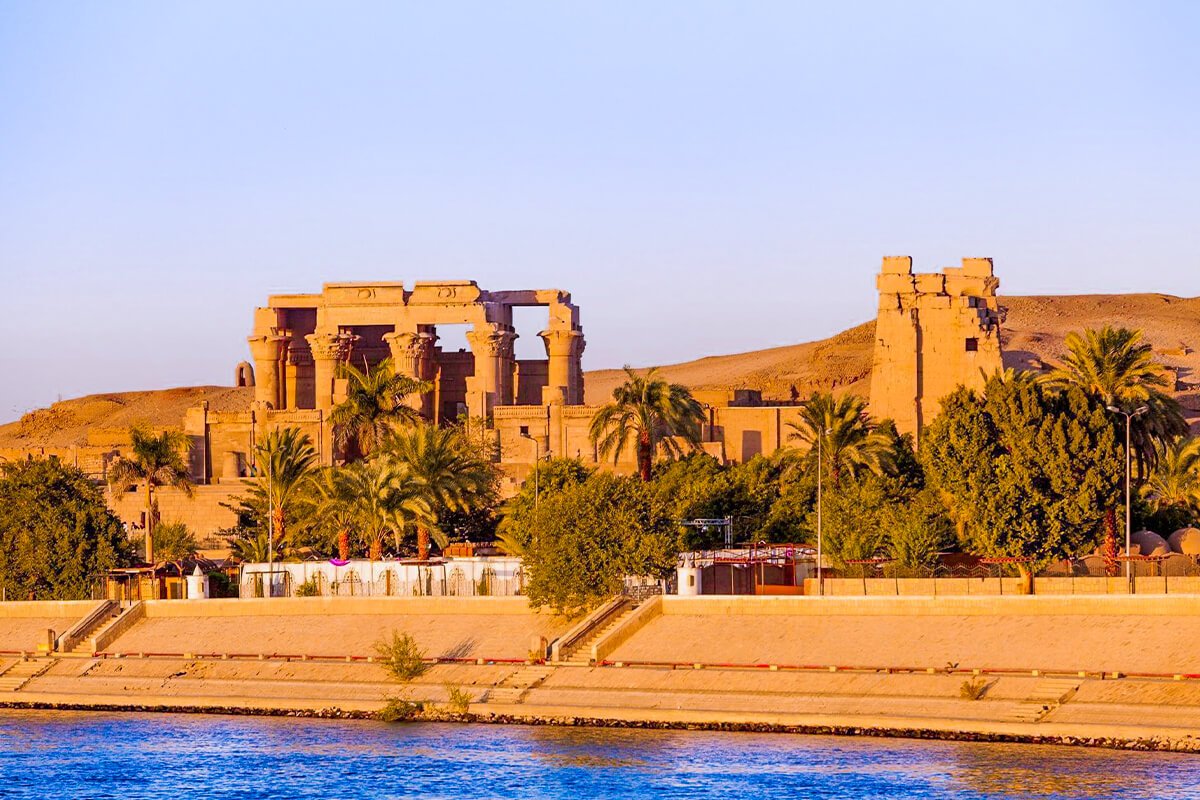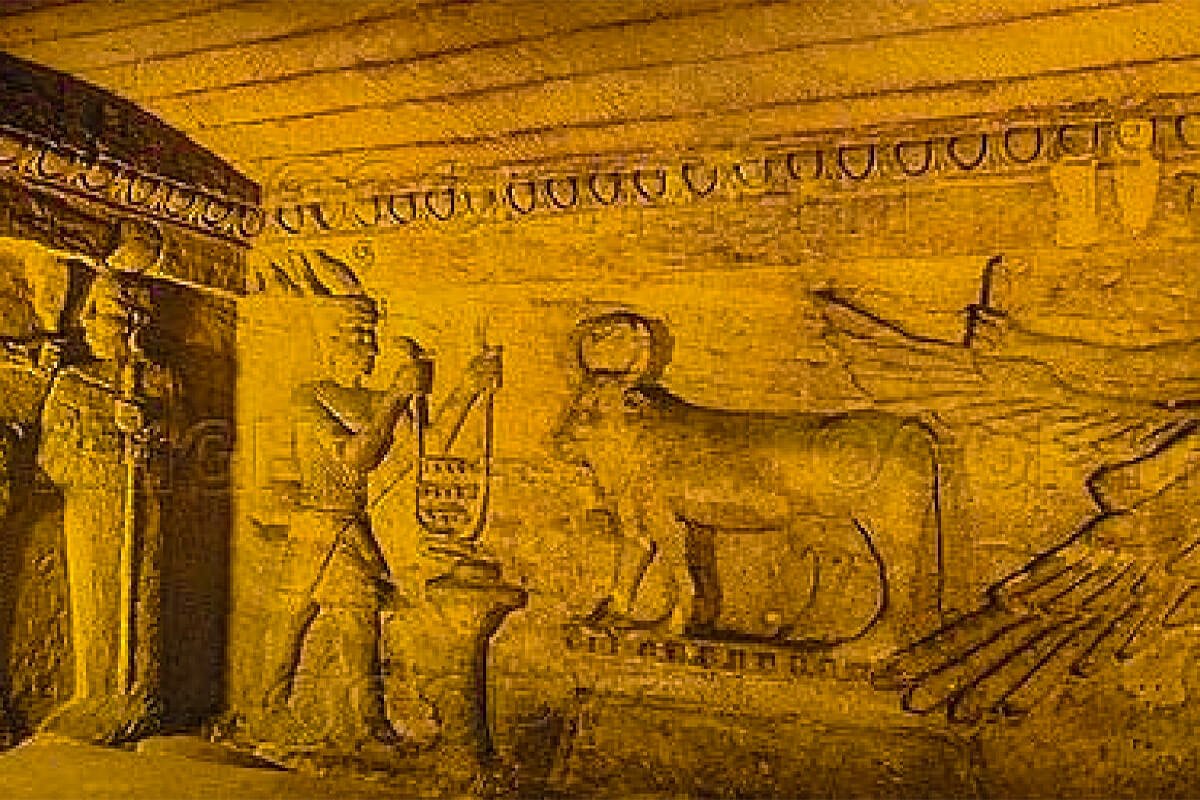Temple of Kom Ombo: Exploring the Ancient Dual Temple
Welcome to the magnificent Temple of Kom Ombo, an extraordinary historical site that takes us back to the ancient land of Egypt. Situated on the east bank of the majestic Nile River, this temple complex is renowned for its unique architectural design and religious significance. Join us on a journey to unravel the secrets of the Temple of Kom Ombo, exploring its captivating history, remarkable features, and cultural importance.
Discover Egypt’s ancient wonders! Book your Egypt Vacation Packages Now!
History and Significance

Historical background of the Temple of Kom Ombo
The Temple of Kom Ombo, nestled on the banks of the Nile, boasts a rich history dating back to the Ptolemaic period, around 180-47 BCE. This ancient marvel is dedicated to two prominent deities: Sobek, the crocodile god, and Horus, the falcon-headed god. Its unique double design sets it apart from other Egyptian temples.
Dual dedication and unique features
What makes Kom Ombo truly exceptional is its dual dedication. One-half of the temple is devoted to Sobek, who was believed to protect against the dangers of the Nile, while the other half venerates Horus, the god of healing. This dual aspect is expressed through separate sanctuaries, courts, and entrances for each deity.
Remarkably, the temple even houses a museum displaying mummified crocodiles, emphasizing the connection between Sobek and this reptile. The architecture itself is a testament to the meticulous craftsmanship of ancient Egyptian builders, featuring intricate carvings and hieroglyphics that tell tales of myths and rituals. It’s like a living history book etched in stone.
Cultural and historical significance
Beyond its architectural grandeur, the Temple of Kom Ombo plays a vital role in understanding the religious and cultural aspects of ancient Egypt. Sobek and Horus were integral to Egyptian mythology and daily life, with Sobek being the protector of the Nile’s fertility and Horus the healer of the sick.
As you wander through the temple, you’ll get a glimpse into the spiritual beliefs and practices that guided the lives of ancient Egyptians. Whether you’re a history enthusiast, a cultural explorer, or simply a curious traveler, this temple holds a treasure trove of significance waiting to be discovered.
Don’t miss checking out our article:
- Explore Egypt Travel Tips to make the most of your trip.
- Uncover the Landmarks in Egypt and step into history.
Location and Accessibility
Geographical location of the temple
The Temple of Kom Ombo, a remarkable ancient structure, is situated in Egypt, specifically along the banks of the majestic Nile River. It’s found in Upper Egypt, near the modern town of Kom Ombo, about 50 kilometers (31 miles) north of Aswan. This temple holds a unique place in history, being a double temple dedicated to two distinct deities: Sobek, the crocodile god, and Horus, the falcon-headed god. The temple’s location in this historically rich region contributes to its significance and allure, making it a must-visit destination for history enthusiasts and curious travelers.
How to reach the Temple of Kom Ombo
Reaching the Temple of Kom Ombo is a relatively straightforward journey. For most tourists, the city of Aswan serves as the starting point. Travelers from various parts of Egypt and the world often arrive in Aswan by air or cruising down the Nile. There are several options for getting to Kom Ombo by road once you’re in Aswan. Many visitors hire a taxi, which provides a convenient and direct route to the temple. Alternatively, group tours and guided excursions are frequently organized, providing not only transportation but also valuable insights from knowledgeable guides.
For those seeking a more adventurous and immersive experience, consider taking a leisurely boat trip from Aswan to Kom Ombo. This scenic voyage along the Nile allows you to soak in the beauty of the river and its surroundings, offering a unique perspective on Egyptian landscapes. Moreover, it’s an opportunity to appreciate the historical significance of the Nile, which was the lifeblood of ancient Egypt. The Temple of Kom Ombo, perched right on its banks, exemplifies this connection.
Nearby attractions and accommodations
While visiting the Temple of Kom Ombo, you’ll find the area rich in historical and natural wonders. As you explore the temple, take a moment to appreciate the stunning view of the Nile, often framed by lush palm groves. Additionally, near the temple complex, you’ll discover a crocodile museum that sheds light on the significance of Sobek, the crocodile god, in ancient Egyptian culture.
If you plan to extend your stay in Kom Ombo, the town offers a range of accommodations catering to different budgets. These include hotels, guesthouses, and even traditional Nubian houses where you can experience local hospitality. Enjoy the tranquility of this riverside town and savor delicious Egyptian cuisine in local restaurants, all while being within easy reach of the temple and its surroundings.

Join us for adventure and discovery on our Egypt Day Tours.
Architectural Marvels
Description of the temple’s architecture
The Temple of Kom Ombo stands as a testament to the extraordinary architectural prowess of the ancient Egyptians. Its unique design is a perfect example of symmetry and duality, reflective of the dual deities it was dedicated to. The temple is divided into two symmetrical sections, each with its entrance, hall, and sanctuary. This double layout is a distinctive feature of the temple, representing the harmonious coexistence of Sobek and Horus.
The structure is predominantly constructed using local sandstone, and its exterior is adorned with ornate columns and walls that have withstood the test of time, allowing us to marvel at the quality of the past. The architecture, aligned with celestial events, also highlights the precision of ancient Egyptian builders.
Intricate carvings and hieroglyphics
The walls of the Temple of Kom Ombo are adorned with intricate carvings and hieroglyphics that narrate stories of the deities, pharaohs, and daily life in ancient Egypt. These carvings serve as a time machine, offering a glimpse into the beliefs and rituals of that era. You’ll find detailed depictions of Sobek, with his distinctive crocodile head, and Horus, the falcon-headed god.
Hieroglyphics, the ancient Egyptian writing system, are etched across the temple’s surfaces, chronicling the religious significance of the site and historical events. As you explore the temple, please take a moment to decipher these fascinating inscriptions and let them transport you back to a civilization that valued the written word and the artistry of storytelling through images.
Notable structures within the temple complex
Within the temple complex, several structures catch the eye and showcase the mastery of ancient Egyptian architects. The most prominent among these is the main sanctuary, which enshrines the sacred statues of Sobek and Horus. Here, you can witness the meticulous craftsmanship that went into creating these deity representations. The inner chambers of the temple are a testament to the precision and engineering skills of the time.
Don’t overlook the impressive columns-supported hypostyle hall and the offering hall, where priests made sacrifices to the gods. Additionally, the temple boasts a nilometer, a unique structure used to measure the water levels of the Nile River, a critical task in a land so reliant on the annual flooding of the river for agricultural success.
Religious and Healing Aspects
Exploration of the temple’s religious significance
The Temple of Kom Ombo held profound religious significance in ancient Egypt. This dual temple was primarily dedicated to two prominent deities in Egyptian mythology – Sobek and Horus. Sobek, the crocodile god, was revered as the god of fertility and the creator of the Nile, attributes closely tied to the life-giving annual flooding of the river. He was also seen as a protective deity, guarding against the dangers of the Nile while simultaneously embodying the ferocity and strength of the crocodile.
In contrast, Horus, the falcon-headed god, was associated with kingship, war, and the sky. His presence in the temple symbolizes the divine protection of the pharaoh and the unification of Upper and Lower Egypt. The Temple of Kom Ombo served as a place of worship and devotion to these deities, and it played a vital role in the religious life of the people of ancient Egypt.
The role of Sobek and Horus in Egyptian mythology
Understanding the roles of Sobek and Horus in Egyptian mythology provides valuable insight into the spiritual significance of the Temple of Kom Ombo. Sobek, as the crocodile god, was seen as a symbol of rebirth and transformation, associated with the regenerative powers of the Nile’s inundation. His image also represented the Nile’s fertile waters that sustained agriculture. On the other hand, Horus, depicted as a falcon, symbolized the sky and its connection to the pharaoh’s divinity.
He was a protector, overseeing the realm of the living and the dead. The dual dedication of the temple to these deities underscored the balance and duality central to Egyptian religious beliefs. The ancient Egyptians saw this balance as essential for harmony in the world, making the Temple of Kom Ombo a place where these beliefs were celebrated and perpetuated.
Healing practices associated with the temple
The Temple of Kom Ombo was not only a place of religious devotion but also a center for healing practices. Historically, it was believed to be a site where miraculous cures and surgeries occurred. The presence of Sobek, associated with fertility and renewal, likely contributed to these healing traditions. Patients came seeking relief from various ailments, and the temple priests were known to perform surgeries, particularly related to eyes, which were seen as a window to the soul.
The hieroglyphics and inscriptions in the temple even include medical instruments, emphasizing the importance of the healing aspect of this site. Visiting the Temple of Kom Ombo today, you can sense the spiritual aura that lingers and appreciate how this place was not just a place of worship but also a sanctuary for those in need of healing, making it a unique and multi-faceted gem of ancient Egyptian culture and belief.

Fun Facts
Interesting tidbits about the Temple of Kom Ombo
As you delve into the fascinating history of the Temple of Kom Ombo, you’ll discover some captivating tidbits that add depth to this remarkable site. One intriguing fact is that it’s a “double” temple, with two symmetrical sections dedicated to Sobek and Horus, providing insight into the Egyptian concept of balance and duality.
Additionally, the temple’s construction aligns with celestial events, such as the solstices, emphasizing the ancient Egyptians’ astronomical knowledge. The alignment of the temple with the annual flooding of the Nile showcases its deep connection to the river that sustained the region’s agriculture.
Unveiling the mysteries of ancient Egypt
Exploring the Temple of Kom Ombo is like embarking on a journey to unveil the mysteries of ancient Egypt. The hieroglyphics that adorn the temple’s walls tell stories of gods, pharaohs, and daily life, providing a glimpse into the beliefs and rituals of this civilization. The dual dedication of the temple to Sobek and Horus reflects the ancient Egyptians’ reverence for balance and symmetry, principles underpinning their worldview.
Delving into Egyptian mythology, you’ll find that Sobek, the crocodile god, symbolized rebirth and fertility, while Horus, the falcon-headed god, represented kingship and protection. This duality is a testament to the depth and complexity of ancient Egyptian beliefs. All in all, the Temple of Kom Ombo is a treasure trove of history and enigma, inviting travelers to immerse themselves in the mystique of one of the world’s most captivating ancient civilizations.
FAQs about the Temple of Kom Ombo
What is the significance of the Temple of Kom Ombo?
The Temple of Kom Ombo holds religious significance as it was dedicated to two important deities, Sobek and Horus. It also served as an educational center for medical teachings.
Why does the Temple of Kom Ombo have a double design?
The double design of the temple represents the dedication to two gods, Sobek and Horus, with each side featuring separate halls and sanctuaries.
Can you visit the Temple of Kom Ombo today?
Yes, the Temple of Kom Ombo is open to visitors and offers a unique opportunity to explore ancient Egyptian architecture and religious beliefs.
What are some notable features of the temple?
The temple’s grand entrance hall, intricate carvings, hypostyle halls, and twin sanctuaries are among its notable features, showcasing the mastery of ancient Egyptian architecture.
Are there any special events or festivals held at the Temple of Kom Ombo?
While no specific events or festivals are held at the temple, the site provides a memorable setting for cultural and historical exploration.
How can I reach the Temple of Kom Ombo?
The Temple of Kom Ombo is located in Upper Egypt, approximately 50 kilometers north of Aswan. You can travel there by car or boat along the Nile River.
Conclusion
As we conclude our journey through the Temple of Kom Ombo, we are left in awe of this ancient Egyptian marvel’s incredible artistry, architectural brilliance, and historical significance. The temple stands as a testament to the ingenuity and devotion of the ancient Egyptians, captivating visitors from around the world. Embark on your own adventure to the Temple of Kom Ombo and experience the enchantment of this extraordinary historical site firsthand.



